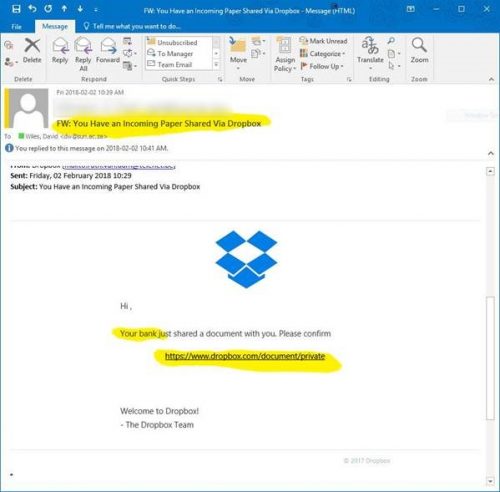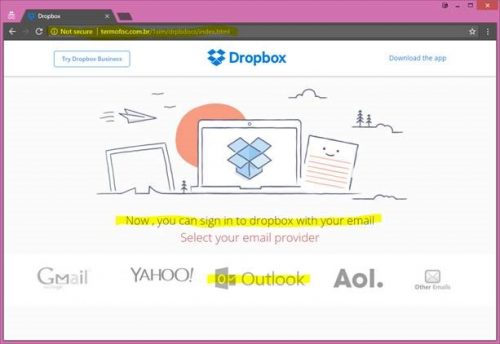If you receive an email from your bank wanting to share a paper via Dropbox with you, be aware that it’s a phishing scam.
If you hover your mouse (don’t click on the Dropbox link) over the link the originating server will appear and it is NOT DropBox, but the phisher’s server, currently based in Brazil. No bank would ever use DropBox to send you documents.
This e-mail has some obvious signs of a phishing scam. First, it does not address you personally, but uses your email address. Also, the email sounds urgent, (it from “your bank”) trying to get you to react quickly without thinking and click on the button. Finally, if you hover over the button, your browser will display the link destination (what is called the spammy URL) at the bottom of the window. The URL does not belong to the alleged sender, Dropbox.

Victims who are fooled into clicking on the link will get the following webpage:

(Notice the links to Outlook Mail and the name of the server that is not Dropbox’s servers but one based in Brazil.)
These criminals want you to divulge your personal details like usernames, passwords etc.
If you have received emails similar to this please report it to the Information Technology Security Team using the following method:
Send the spam/phishing mail to help@sun.ac.za and sysadm@sun.ac.za.
Attach the phishing or suspicious mail on to the message if possible. There is a good tutorial on how to do this at the following link (Which is safe) : http://stbsp01.stb.sun.ac.za/innov/it/it-help/Wiki%20Pages/Spam%20sysadmin%20Eng.aspx
- Start up a new mail addressed to sysadm@sun.ac.za (CC: help@sun.ac.za)
- Use the Title “SPAM” (without quotes) in the Subject.
- With this New Mail window open, drag the suspicious spam/phishing mail from your Inbox into the New Mail Window. It will attach the mail as an enclosure and a small icon with a light yellow envelope will appear in the attachments section of the New Mail.
- Send the mail.
IF YOU HAVE FALLEN FOR THE SCAM:
If you did click on the link of this phishing spam and unwittingly give the scammers your username, e-mail address and password you should immediately go to http://www.sun.ac.za/useradm and change the passwords on ALL your university accounts (making sure the new password is completely different, and is a strong password that will not be easily guessed.) as well as changing the passwords on your social media and private e-mail accounts (especially if you use the same passwords on these accounts.)
IT have set up a website page with useful information on how to report and combat phishing and spam. The address is: https://blogs.sun.ac.za/it/en/2017/11/reporting-spam-malware-and-phishing/
[Article by David Wiles]

